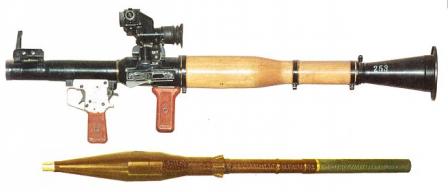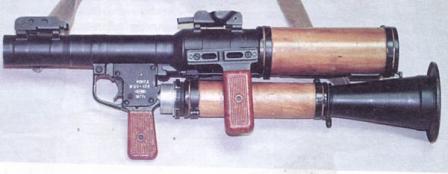
RPG-7V antitank grenade launcher with PGO-7 telescope sight and a PG-7VM grenade in ready to load condition (with launch charge attached).

RPG-7D antitank grenade launcher (version for airborne troops), disassembled for transportation / airdrop.

PG-7VR tandem (dual-warhead) HEAT grenade.

TBG-7V Thermobaric (FAE) grenade.

OG-7V fragmentation antipersonnel grenade (1999).
Caliber: 40 mm launcher; 40 and 70 – 105mm warheads (depending on the grenade model)
Type: recoilless launch + rocket booster
Overall length: 650 mm
Weight: 6.3 kg unloaded, with PGO-7 telescope sight
Effective range: 200-500 meters, depending on the grenade type
Some grenades, used in RPG-7 (Soviet/Russian origins)
| PG-7V | PG-7VL | PG-7VR | TBG-7V | OG-7V | |
| Year of adoption | 1961 | 1977 | 1988 | 1988 | 1999 |
| Warhead caliber, mm | 85 | 93 | 64 / 105 | 105 | 40 |
| Weight, kg | 2.2 | 2.6 | 4.5 | 4.5 | 2.0 |
| Effective range, meters | 500 | 500 | 200 | 200 | 350 |
| Armor penetration, mm | 260 | 500 | ERA + 600-700 | – | – |
The RPG-7 grenade launcher (RPG-7 in Russian stands for РПГ-7 – Ручной Противотанковый Гранатомет 7, hand-held antitank grenade launcher) is a further development of the previous RPG-2 antitank grenade launcher. The RPG-7, in its first version, known as RPG-7V, has been adopted by Soviet army in 1961, and still is widely fielded in Russia and at least 50 more countries. By far, RPG-7 can be considered as one of the most successful antitank grenade launchers ever made.Initially thought as an anti-armor weapon, it latter has been adopted for other fire-support missions by introduction of various types of grenades, such as anti-infantry HE-FRAG, multi-purpose Thermobaric / FAE, and some other types of ammunition. The antitank grenades for RPG-7 also came a long way, from original PG-7V grenade, with penetration of about 260mm/10inches of RHA, and up to 500mm/20inches of RHAor 1.5 meters/5ft of brick wall with single-warhead PG-7VL grenade, developed in 1977. By the late 1980s, a tandem-type PG-7VR grenade has been introduced. This grenade has two warheads and is intended against the most modern tanks, fitted with ERA (Explosive Reactive Armor). Front warhead sets off the ERA, and second warhead then penetrates more than 600mm/24in of armor.
The RPG-7 is a shoulder fired, single-shot, smoothbore recoilless launcher. Grenades are loaded from the front, and the rear of the barrel is fitted with venturi nozzle. Because of the recoilless design, there is a dangerous backblast zone, more than 20 meters/60ft long. The antitank grenades are of combination type, using a charge of smokeless powder for RCL-type launch. Once grenade reaches safe distance from the shooter (about 10-20 meters), the built-in rocket booster engine ignites and further accelerates the grenade, greatly enhancing the effective range (up to 500+ meters for single warhead grenades, up to200+ meters for much heavier tandem or FAE grenades). Because of increase in range, RPG-7 is usually issued with 2.7X fixed magnification optical sight, designated PGO-7. The sight has a range-finding scale for typical targets (tanks) with height of 2.7m/9ft, and windage adjustment scales. RPG-7 also fitted with backup iron sights. RPG-7 uses mechanical ignition system with manually cocked external hammer, and a single-action trigger. Because of this, grenade must be properly aligned with the firing mechanism upon loading.
Each AT grenade consists of a large-caliber HEAT warhead with base fuse, with the 40mm diameter rocket engine behind. The rocket nozzles are located at the front of the engine, close to the warhead. The tail of the rocket is fitted with folding stabiliztator fins, which are extended when grenade leaves the barrel. The launch charge, made of black powder, is loaded into a combustible cardboard case, and attached to the rear of the grenade prior to loading into launcher. Grenades and launch charges are carried in special backpacks. By the original soviet standards, grenadier carries two rounds, and his assistant carries three more. There were several minor upgrades to the basic design of the RPG-7 in USSR and Russia, the most important being the RPG-7D, with two-part takedown barrel, which was issued to the airborne troops. Since RPG-7 was, and still is manufactured in many countries(such as Bulgaria, China, Iraq and Romania, to name a few), there are plenty of modifications in launcher, and, more important, in grenades.
RPG-7 is a simple and inexpensive weapon, yet it still possess a significant threat to most modern tanks, and also can serve in a number of other roles, making it a true one-man artillery.